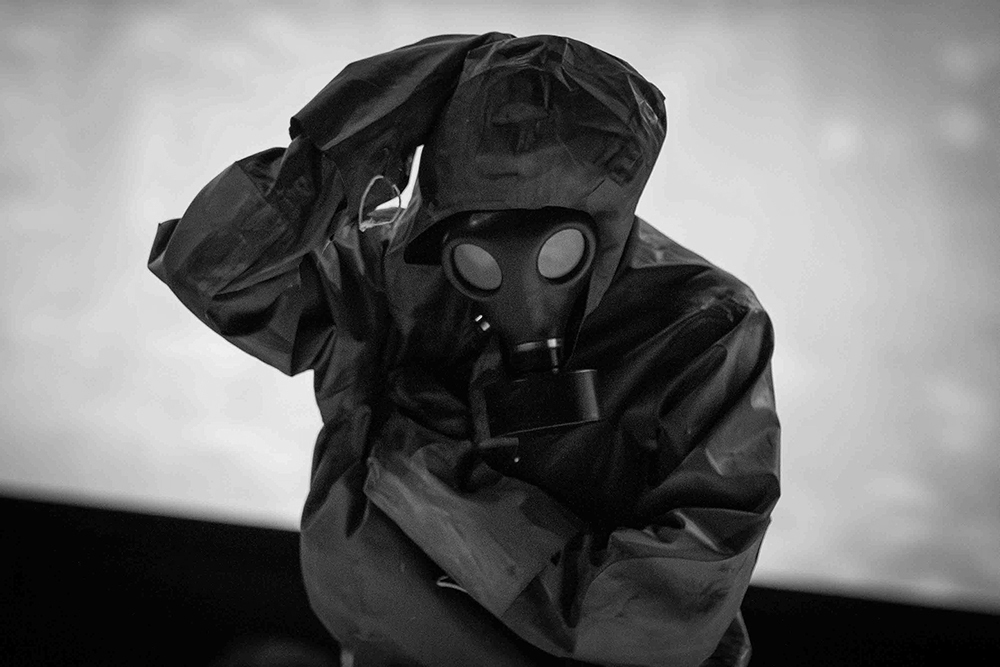B’Tselem is the Israeli Information Center for Human Rights in the Occupied Territories. Since 2007, the organization has been operating its Camera Project, which distributes video cameras to Palestinians in high conflict areas in the West Bank. The project aims to provide an ongoing documentation of human rights violations, and to expose the reality of life under occupation to both the Israeli and the international public.
Throughout the work process, Zaides reviewed and selected footage that was filmed by volunteers of B’Tselem’s Camera Project. On stage, he examines the bodies of Israelis as they were captured on camera, and focuses on the physical reactions to which they resort in various confrontational situations. The Palestinians remain behind the camera, nevertheless, their movement, voice, and point of view are highly present, determining the viewer’s perspective.
Although the footage reveals a local reality, Archive raises broader, more universal questions: what is the potential of violence embedded in each individual body, and what price does the collective pay for governing the other. Zaides extracts and appropriates gestures and voices of fellow Israelis. He identifies with the footage and engages in it, gradually embodying it. The mimetic choreographic practice raises questions of participation and responsibility as Zaides’ body transforms into a living archive.
PAST PERFORMANCES
Festival d’Avignon, Avignon (FR); Kunstenfestivaldesarts, Brussels (BE); Festival TransAmériques, Montreal (CA); Itaú Cultural, MITSP, São Paulo, (BR); The Off Broadway Theater, Yale Institute of Sacred Music, Yale University, New Haven (US); Festival Dansem, Montevideo, Marseille (FR); CDC Toulouse, Toulouse (FR); CNDC Angers, Angers (FR); Théâtre National de Chaillot, Paris (FR); T-Werk, Fabrik Potsdam (DE); De Keuze Festival, Rotterdamse Schouwburg, Rotterdam (NL); International Festival of the Arts of Terni, Terni (IT); Oriente Occidente Festival, Rovereto (IT); Santarcangelo Festival, Santarcangelo (IT); Tatra Studio, International Festival Divadelná Nitra, Nitra (SK); Warande, Turnhout (BE); International Exposure Festival, Tmuna Theater, Tel Aviv (IL/PS); La Halle Aux Grains, Blois (FR); 4+4 Days in Motion Festival, Prague (SZ); Bastard Festival, Teaterhuset Avant Garden, Trondheim (NO); Best of the Fest Festival, Park Theater, Eindhoven (NL); Gothenburg Dance & Theater Festival, Gothenburg (SE); Alkantara Festival, Teatro São Luiz, Lisbon (PT); Onassis Cultural Centre, Athens (GR); Pôle Sud, Strasbourg (FR); Tanzquartier Wien, Vienna (AT); STUK, Leuven (BE); CSS Teatro Stabile di Innovazione del FVG, Udine (IT); Black Box Theater, Oslo (NO); BIT Teatergarasjen, Bergen (NO); New York Live Arts, New York City (US); Escenas Do Cambio Festival, Santiago de Compostela (ES); HAU Hebbel am Ufer, Berlin (DE); Kroki Festival, Malopolski Ogród Sztuki, Krakow (PL); Théâtre des Quatre Saisons, Gradignan (FR); Teatro Campos, Bilbao (ES); Spoiwa Festival, Trafo, Szczecin (PL); CCN de Nantes, Nantes (FR); Zurich Moves, Tanzhaus Zurich, Zurich (CH); La Vignette, Paul-Valéry University Montpellier 3 (FR); La Mutant, Valencia (ES); Ambulante Festival, Mexico City (MX); Teatros del Canal, Madrid (ES)
